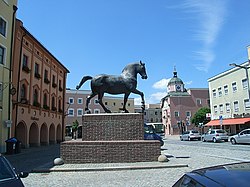Pfarrkirchen
You can help expand this article with text translated from the corresponding article in German. (March 2009) Click [show] for important translation instructions.
|
Pfarrkirchen | |
|---|---|
 Part of town square | |
Location of Pfarrkirchen within Rottal-Inn district  | |
| Coordinates: 48°25′N 12°55′E / 48.417°N 12.917°E | |
| Country | Germany |
| State | Bavaria |
| Admin. region | Lower Bavaria |
| District | Rottal-Inn |
| Government | |
| • Mayor (2020–26) | Wolfgang Beißmann[1] (CSU) |
| Area | |
| • Total | 52.33 km2 (20.20 sq mi) |
| Elevation | 381 m (1,250 ft) |
| Population (2022-12-31)[2] | |
| • Total | 13,522 |
| • Density | 260/km2 (670/sq mi) |
| Time zone | UTC+01:00 (CET) |
| • Summer (DST) | UTC+02:00 (CEST) |
| Postal codes | 84347 |
| Dialling codes | 08561 |
| Vehicle registration | PAN |
| Website | pfarrkirchen.de |
Pfarrkirchen is a
History
The first settlers came to Pfarrkirchen some 7,000 years ago, as excavations in Untergaiching (a small suburb) prove. The first official written document where the name "Pharrachiricha" is mentioned, appeared in between 875 and 899 AD by the Catholic Bishop "Engilmar". The name means "parish church". In 1262 Pfarrkirchen and the nearby "Castle Reichenberg" passed into the possession of the Bavarian dynasty
Places of interest
The town's best known landmark is the "Gartlbergkirche", a
Another well known sight of Pfarrkirchen is the so-called "Wimmer-Roß", an oversized bronze statue, which is located at the heart of the town, showing a black stallion. It was built in 1942 by the sculptor Hans Wimmer, who donated the statue to his hometown. It symbolizes the high status of horse breeding in the Rottal region. Pfarrkirchen also possesses Bavaria's oldest
Twin towns - sister cities
 Saint-Rémy-de-Provence, southern France, since 1991
Saint-Rémy-de-Provence, southern France, since 1991 The region Luzerner Rottal comprising the towns Ruswil, Ettswil, Buttisholz, and Grosswangen in Switzerland, since 1997
The region Luzerner Rottal comprising the towns Ruswil, Ettswil, Buttisholz, and Grosswangen in Switzerland, since 1997 San Vincenzo, Tuscany, Italy, since 1998
San Vincenzo, Tuscany, Italy, since 1998
Notable people
- Conrad Fink (1900–1981), politician
References
- Bayerisches Landesamt für Statistik, 15 July 2021.
- ^ Genesis Online-Datenbank des Bayerischen Landesamtes für Statistik Tabelle 12411-003r Fortschreibung des Bevölkerungsstandes: Gemeinden, Stichtag (Einwohnerzahlen auf Grundlage des Zensus 2011).
External links
- Official website
 (in German)
(in German)




